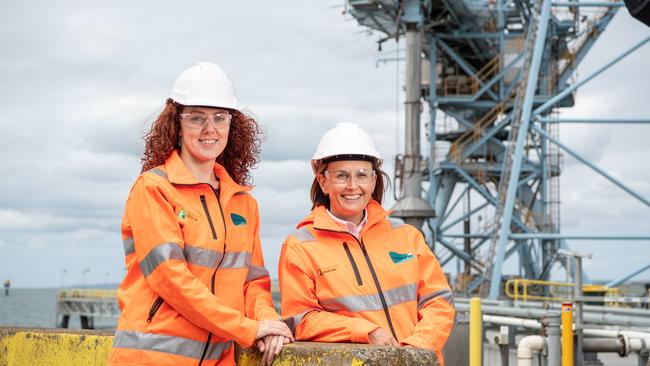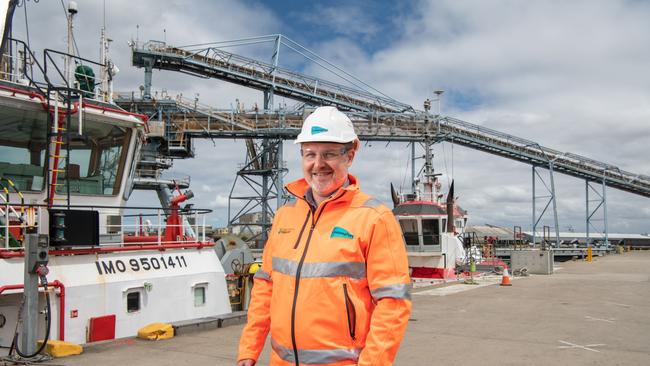Why Geelong’s port is undergoing a ‘renaissance period’
When a cattle ship first docked in Corio Bay in the 1800s, residents had no idea it would lead to a $7bn hub of industry.

Geelong
Don't miss out on the headlines from Geelong. Followed categories will be added to My News.
When a livestock ship first docked in Corio Bay in the 1800s, residents had no idea it would lead to a $7bn hub of industry.
Victoria’s second-largest port manages 12 million tonnes of cargo and around 600 ships per year, across the energy, agriculture, construction and tourism sectors.
The 90ha GeelongPort site operates across 50 berths and manages more than $7bn of trade annually across precincts at Corio Quay and Lascelles Wharf.
Major imports include crude oil, woodchips, petrol, cement clinker and other cargo servicing companies like Viva Energy, Midway, Boral and Incitec Pivot.
The port has been part of the fabric of the growing city since 1836, when the first vessel docked carrying cattle and sheep.
It has been a fully-fledged commercial operation since 1881.
GeelongPort chief executive Brett Winter said the history of the port and the city went hand-in-hand.

“The port has been central to both the economic prosperity of the region, and more broadly the social fabric of the community for a long time,” he said.
“We support a range of industries, and it’s a very unique asset for the Geelong region.”
Estimates revealed the port is expected to handle up to 18 million tonnes of cargo each year by 2035, generating up to $11bn.
One of Australia’s greenest ports, sustainability has long been at the forefront of operations.
Last year the port announced it would develop up to 25ha of land for a wind farm hub at Oyster Cove, near Lascelles Wharf.
It will provide “bespoke” facilities for construction, laydown and berthing for on and offshore wind farm projects.
It would support the state government’s offshore wind targets, as well as projects like Australia’s largest wind farm under construction at Rokewood.

“We’re still in the planning phase at the moment, but we’re engaging with a number of operators who are looking to establish wind farms as part of the government’s offshore wind program,” Mr Winter said.
“There’s a huge amount of interest and demand.”
In 2021, the port was the first in Australia to achieve carbon-neutral certification in its business operations.
Other recent investments include an investigation into the establishment of a hydrogen production facility, and a $130m new clinker grinding and cement facility commissioned by Boral.
Mr Winter described the heavy investment in the precinct as a “renaissance period”.
GeelongPort was bolstered late last year with the arrival of the Spirit of Tasmania to its new 12ha home off Corio Quay Rd.
The purpose-built facility will welcome the popular ship’s 450,000 visitors each year, and is expected to increase tourism expenditure in the region by up to $174m by 2029.
The Spirit of Tasmania’s new $130m home officially opened late last year.
Two new Finnish-built vessels with the capacity for 1800 passengers are expected to land next year.
Tourism Greater Geelong and the Bellarine chief executive Tracy Carter said there had been an increase in people adding the region to their itinerary after a boat trip.
“We’re definitely seeing people arriving early, or staying beyond their arrival to spend time in Geelong,” she said.
“People want to eat out, or try different experiences in the city.”
New infrastructure at the site included a world-first, three-level ramp that allows caravans, cars and boats to board simultaneously.
The new hub houses a state-of-the-art terminal building, cafe and boarding area with capacity to marshal 600 cars and 150 trucks.
It’s estimated the new terminal supports up to 100 full-time jobs.
“The Spirit of Tasmania has been absolutely transformative for the port,” Mr Winter said.
“Business is going gangbusters at the moment and they are fully booked.”
More Coverage
Originally published as Why Geelong’s port is undergoing a ‘renaissance period’




